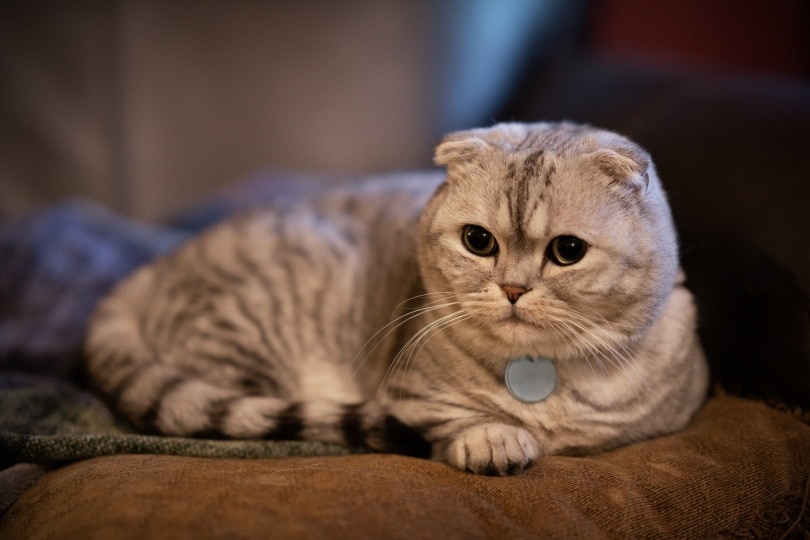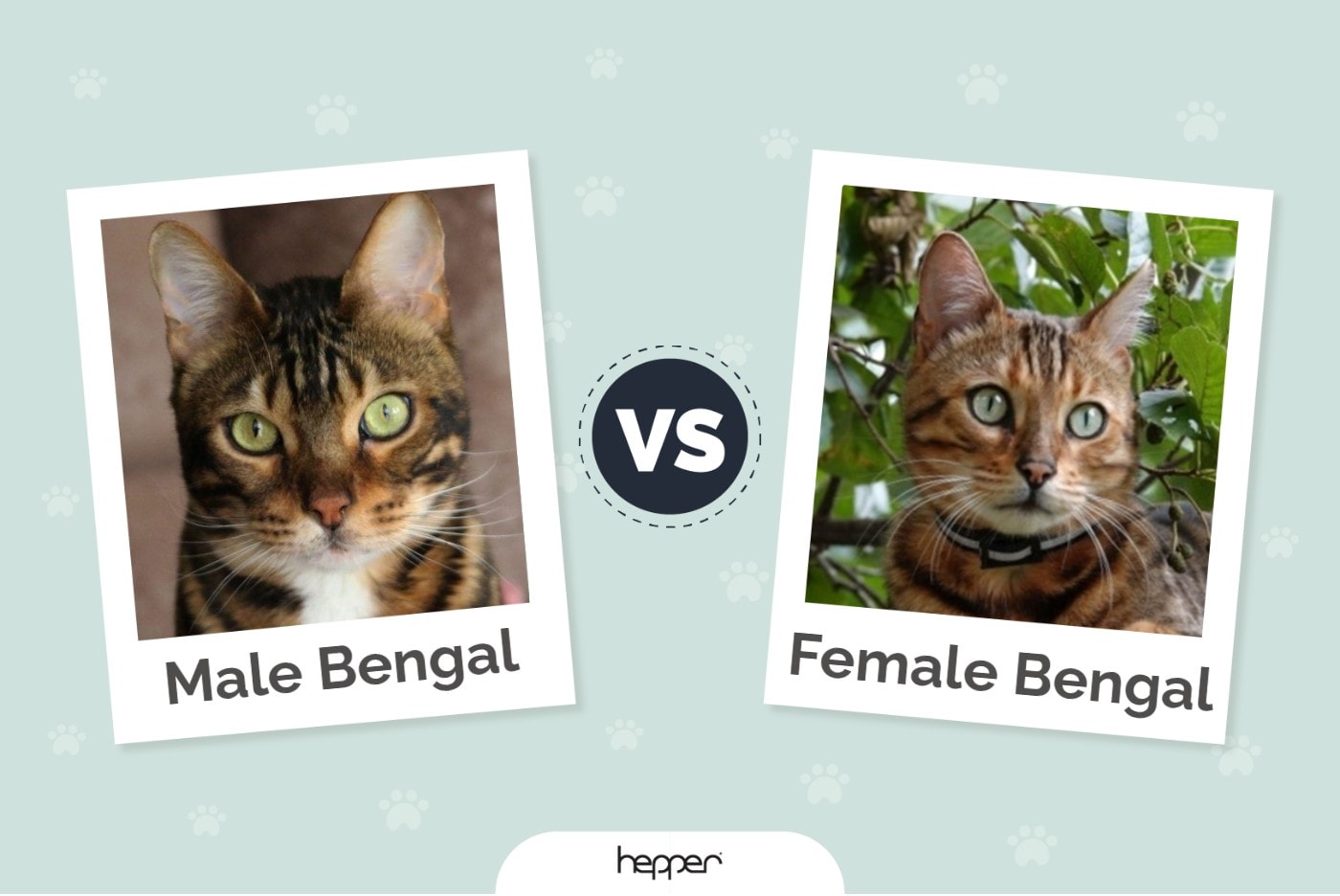How to Feed Your Cat: Vet-Reviewed Beginner’s Guide
Updated on
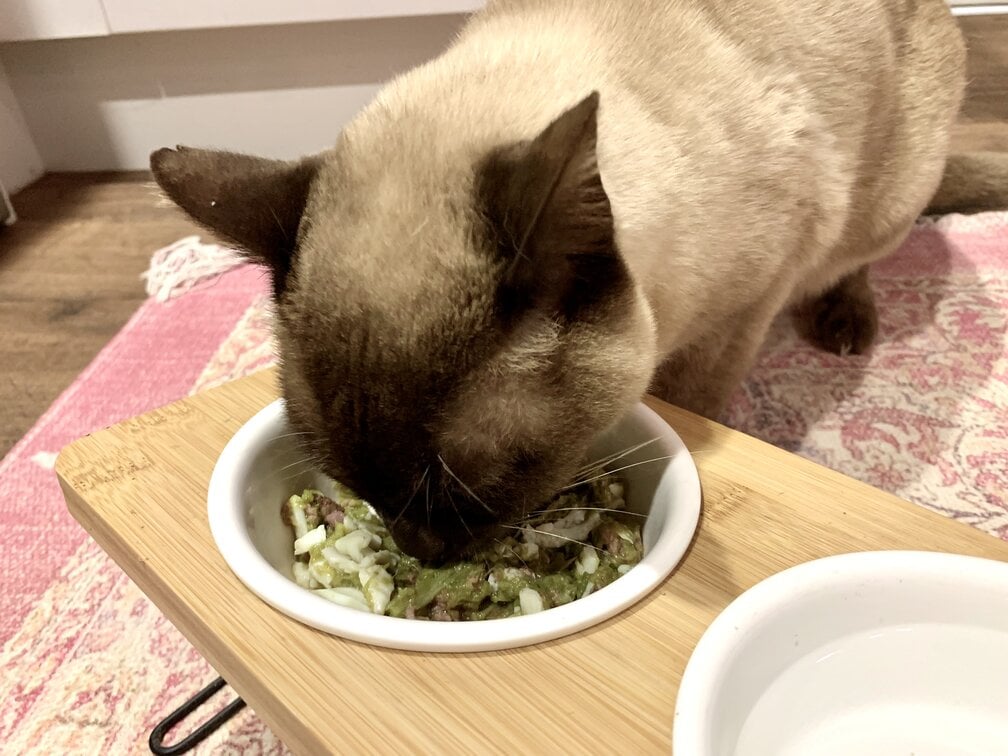
Just like all pets, cats have very specific dietary needs. They require the proper food in the proper amount for repair, growth, maintenance, repair, and other biological processes. If things were not complicated enough, your feline’s needs will change based on several factors, such as their age and neuter status. Therefore, what works for them now may not work for them later.
Luckily, while feeding your cat can sound complicated, it becomes easier by following a few fundamental principles. Below, we will jump into tips on how to choose the right food and how to correctly feed your cat.
How to Feed Your Cat in 4 Steps
1. Choose Appropriate Cat Food
Before you can even start feeding your feline, you need to choose food that is acceptable for a cat. Cats are obligate carnivores, which means they consume mostly animal-based protein and fat to thrive. Therefore, the best cat food will be high in animal-derived protein and fats.
For someone new to feeding a cat, figuring out what to purchase or prepare for your cat might seem daunting. Commercial foods are often manufactured with standards that ensure complete nutrition for pets, and therefore, might be a safer option. However, there are pros and cons to any nutritional style you choose for your cat.
- AAFCO Certified: In the US, The Association of American Feed Control Officials sets nutritional standards for cat food. You should only purchase food with their seal. Otherwise, it may not be complete and contain all the nutrients your cat needs. If you do not reside in the US, look for the stamp of your region’s food governing institution.
- Life Stage: The life stage of your cat may help narrow down your choices. Food formulated for kittens typically has higher protein and fat than food intended for an adult cat. If your cat is an adult, you might want to opt for adult cat food for them. Many companies also manufacture foods for specific breeds of cats, intended to help with their needs.
- Special Needs: Some cats may have health conditions that require a specific diet, such as diabetes, kidney disease, or allergies. Consult with your veterinarian if your cat needs a prescription or therapeutic diet. Do not attempt to self-diagnose your cat. Prescription diets do not treat medical conditions and should only be used at a veterinarian’s discretion.
- Canned or Dry: Both types of cat food have advantages and disadvantages. Canned food has more moisture, which can help cats stay better Dry food is more economical and convenient. Ultimately, there’s no right or wrong here, and if you’re unsure, it’s best to consult your veterinarian for advice.
Fresh and raw diets are rising in popularity and may also be available commercially. These diets being more natural seem to add to their appeal, and they have many anecdotal benefits for pets, such as an improved coat and better energy levels. Consult your veterinarian if you’re considering a fresh or raw diet for your pet cat.
Many people seem to be dissuaded from such diets because they think they are time-consuming to prepare. However, many manufacturers offer meal subscription plans that deliver a constant supply of food for your pet, making the process easier.
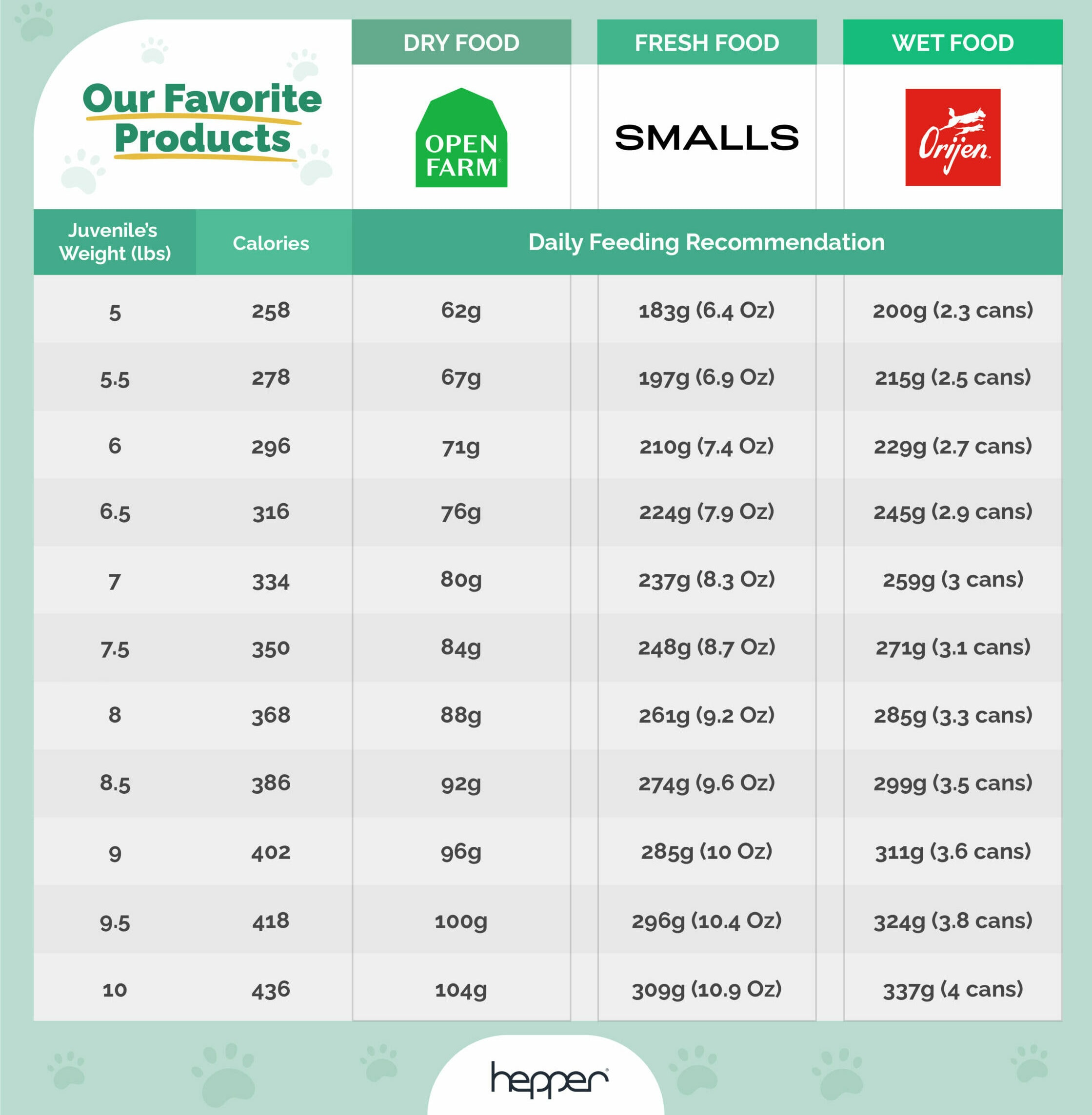
Important Note: The amount of calories each cat needs for healthy growth and development depends on many factors, including their age, breed, and activity level. The chart above is a general guideline for healthy young cats, but we always recommend confirming any diet changes with your vet.
2. Determining the Amount of Food
Next, you need to figure out exactly how much food your cat needs each day. Several factors play a part in this: your cat’s neuter status, activity level, current body condition score, and the aim of the diet itself are just some factors that come into play. Suffice it to say, there is no one-size-fits-all answer here.
Luckily, this does not have to be too complicated. If you’ve purchased commercial food, they often come with a guideline on how much to feed your cat based on their weight, age, and other factors. They usually provide a recommended daily amount based on your cat’s weight range. However, these are only estimates and may not suit every cat’s individual needs. Therefore, it’s best to consult your veterinarian for any doubts you may have about feeding your cat.
A good idea is to keep an eye on your cat’s weight periodically to see if they’re getting enough food. However, this isn’t considered a reliable way to determine if they are being fed enough, as many other diseases or ailments can lead to either weight loss or weight gain. The one thing to be mindful of is that a sudden drastic change in weight (either an increase or decrease) always warrants veterinary attention.
You can complement this valuable information by using our cat food calculator here:
The exact amount of calories an individual animal needs to maintain a healthy weight is variable and influenced by many factors including genetics, age, breed, and activity level. This tool is meant to be used only as a guideline for healthy individuals and does not substitute veterinary advice
3. Establish a Schedule
On top of the right food and the right amount of food, you also need the correct feeding schedule. A feeding routine is essential for cats. This will help your cat know when to expect their meals and avoid begging or overeating. It will also help you keep track of their food intake and appetite.
You do not have to feed your cat at exactly the same time every day, but you do want to get it around the same time.
Adult cats are usually fed twice a day (assuming they are healthy). The morning and evening are best. You may need to feed kittens more frequently, depending on their age.
Use feeding toys or puzzles to make feeding more fun and stimulating for your cat. These are devices that dispense food when your cat plays with them or solves them. They can help keep your cat entertained and active. If your cat eats very quickly, they can help them slow down and prevent vomiting.
Always put your cat’s food in a quiet location. Otherwise, your cat may be stressed when trying to eat. This may cause them to eat too little or eat too fast—both are less than optimal. Don’t place the food near water bowls or litter boxes, as many cats prefer their food area to be completely separate.
You should not allow your cat to have access to food at all times, as cats are very poor at self-regulation and may readily overeat if the opportunity arises.
4. Don’t Forget Water
On top of food, your cat also needs a reasonable amount of water. Providing fresh, clean water is essential, so you should change their water for every feeding session.
Many cats like a water fountain or drip faucet, as they’re intrigued by flowing water, as it tends to pique their curiosity.
If your cat does not drink enough water, you may have to switch to canned food. Canned food can be up to 78% water, so your cat can increase their water intake substantially by choosing canned food. Alternatively, you could top their food with a gravy made specifically for cats. However, please note that a refusal to drink water should not be taken lightly, and you should consult your veterinarian if you suspect that your cat is dehydrated.
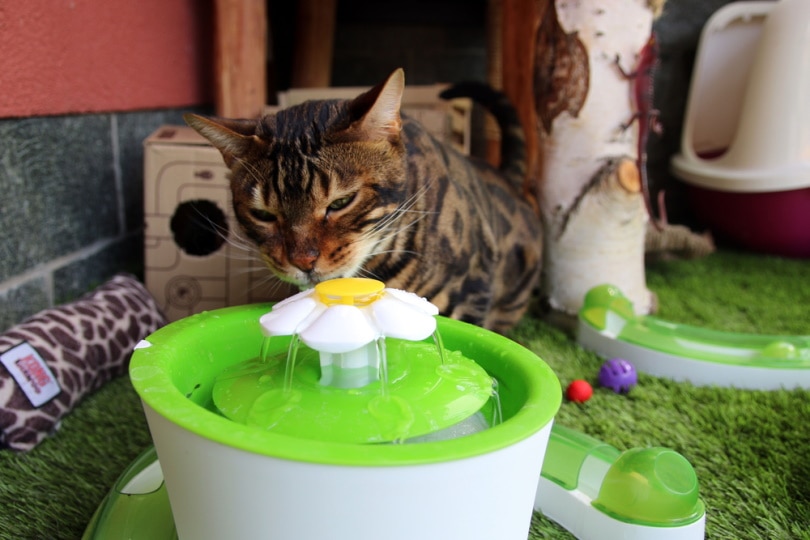
Treats & Cats
There are many treats in the market for cats. Treats, in moderation, are considered acceptable for cats. Moderation means that they should only constitute around 5% of their daily nutritional intake. Cats can quickly condition themselves to beg for treats, especially if they realize it’s very easy to get a treat out of you by constantly crying and begging for them. It is important to not overindulge your cat in treats, as this can lead to an overweight pet (and all the problems associated with an overweight pet).
Other Feline Culinary Aspirations
Once you’ve mastered the basics of feeding your cat, it becomes much easier to branch off into exploring topics like a dietary transition, cooking meals for your cat, or considering a different meal plan for your cat. As always, it is best to consult your veterinarian before deciding to do so, as a clean bill of health is necessary before dietary modifications are attempted.
While providing our feline companions with high-quality food is paramount, selecting the right food and water bowl is equally important. The modern yet practical design of our Hepper NomNom Cat Bowl combines cat-catered features, like whisker-friendly shallow dishes and slight elevation, with a contemporary style aimed at protecting your floors from messy eating and drinking. The NomNom is entirely dishwasher safe and was thoughtfully created with your cat’s health and well-being in mind.
Conclusion
Feeding your cat correctly is vital to their well-being. A poorly fed cat simply cannot thrive. If you are new to picking out a meal plan for your cat, it’s best to follow your veterinarian’s advice to ensure that your cat is getting food that is appropriate for them. Keep in mind that not all foods may be appropriate for your cat, especially if they have an underlying health condition.
You’ll need to ensure you choose the right amount of food and feed it in the correct amount. You’ll also need to set up a feeding routine and place their feeding bowl in the correct place. Some cats may need some extra care, such as those that eat too fast.
Food is important, but hydration is also vital. You should always provide fresh, clean drinking water and ensure that your cat is staying hydrated.
- Related Read: Harmful Foods Your Cat Should Never Eat
Featured Image Credit: Nicole Cosgrove | Hepper





